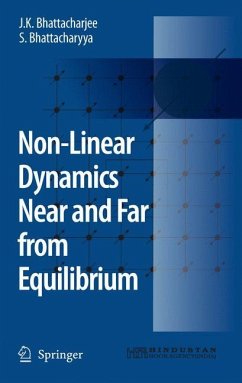We will be concerned mainly with systems with in?nite degrees of freedom which can however, be described by a few variables. These variables must necessarily be ?elds i. e. functions of space and time. A typical example would be to try to describethe?owofairaroundus. Thevariablesthatwouldbenecessarytodescribe the state of air would certainly be its density, its temperature and its velocity. All these variables (density, temperature and velocity) are, in general, functions of space and time. They are mesoscopic variables. They do not re?ect the variations occurring at the molecular level. To de?ne a density, it should be recalled, we take a small volume (small compared to the total system size, yet large compared to atomic dimensions) and consider the mass of this small volume. The ratio of mass tovolumeremainsconstantforareasonablylargevariationinthesizeofthevolume chosen and de?nes the density of the system. It fails to be a constant if the volume becomessosmallthatitcontainsonlyafewmolecules. Inthatcaseourdescription in terms of a density fails. All the systems that we will talk about can be described in terms of a coarse grained ?eld like the density. Because of the smallness (at the macroscopic level) of the volume used in de?ning density it can be considered a local variable. This is what makes it a ?eld. Similarly we can talk about the local temperature and local velocity. The local velocity is not the velocity of an individual molecule but the velocity associated with a macroscopically small, yet microscopicallylargevolumeofair.
From the reviews:
"The text pays particular attention to the universal behavior of critical phenomena and focuses on the renormalization group methods in the study of the dynamics of nonlinear continuous systems near and far from equilibrium. ... The book should be useful to physics graduates and research workers who wish to find a comprehensive introduction to applied statistical mechanics, with detailed analytic results when available." (Piotr Garbaczewski, Zentralblatt MATH, Vol. 1114 (16), 2007)
"This book gives an excellent introduction to the field-theoretic approach to equilibrium and non-equilibrium phenomena. ... The book will certainly be very interesting and helpful for young researchers and graduate students. More advanced readers may find the book useful as an updated handbook that brings further insight into detailed renormalization group calculations with a variety of applications to equilibrium and non-equilibrium condensed matter problems." (Nick Laskin, Mathematical Reviews, Issue 2008 b)
"The text pays particular attention to the universal behavior of critical phenomena and focuses on the renormalization group methods in the study of the dynamics of nonlinear continuous systems near and far from equilibrium. ... The book should be useful to physics graduates and research workers who wish to find a comprehensive introduction to applied statistical mechanics, with detailed analytic results when available." (Piotr Garbaczewski, Zentralblatt MATH, Vol. 1114 (16), 2007)
"This book gives an excellent introduction to the field-theoretic approach to equilibrium and non-equilibrium phenomena. ... The book will certainly be very interesting and helpful for young researchers and graduate students. More advanced readers may find the book useful as an updated handbook that brings further insight into detailed renormalization group calculations with a variety of applications to equilibrium and non-equilibrium condensed matter problems." (Nick Laskin, Mathematical Reviews, Issue 2008 b)







